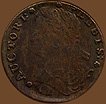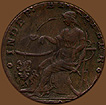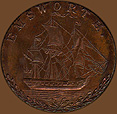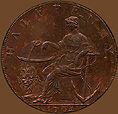Auctori Plebis Token 1787
obverse |
|
reverse |
| |||
1787 Auctori Plebis Token
Obverse: [cinquefoil] AUCTORI : [cinquefoil] [cinquefoil]
PLEBIS : [cinquefoil]
Reverse: [ring] INDEP : ET . LIBER [ring] 1787
Weight: 107.5 g (6.97 grams) Diameter: 26.6 mm Reverse die alignment: 180°
Comments: The obverse bust was cut shallow in the die and so was weakly struck. Note that in AUCTORIS, the letters TOR are smaller than the other letters. Also, in this example there is a larger planchet void and several small voids in the top portion of the bust area.
The reverse die appears to have been larger than the planchet, for most examples appear incomplete (note the planchet size is 26.6 mm while the Emsworth token, listed next, is 29.4 mm). The present example has only a small portion of the date area and is struck right of center so that the upper portion of LIBER and part of the anchor are lost. On this example there are massive die cracks from the left tip of the anchor moving up behind Liberty's head; a second crack starts in the hair area then continues through her forehead and on to just before the globe. As these cracks do not appear on many plated examples I suspect they occurred in the final stages of the use of these dies.
Provenance: From the Robert H. Gore, Jr. Numismatic Collection.
Emsworth Token
obverse |
|
reverse |
| |||
1794 Batty, 299 Dalton and Hamer, Hampsire, Emsworth 10 Emsworth Token for John Stride, Hampshire
Obverse: EMSWORTH .
Reverse: HALFPENNY . 1794
Edge: PAYABLE AT THE WAREHOUSE OF IOHN STRIDE X X X X
[click here for samples of the edge, sample 1 ; sample 2 ; sample 3 ; sample 4 and sample 5]
Weight: 135.7 g (8.80 grams) Diameter: 29.4 mm Reverse die alignment: 180°
Comments: A 1794 Emsworth token, made for the grocer John Stride. Breen attributes the Emsworth tokens to Peter Kempson and Sons of Birmingham. The obverse with a ship at sea and laurel branches below is well struck. In the legend note the H is rather distant from the other letters with the bottom inside serifs almost touching. There is also a major die crack on the obverse moving from below the first upright of the H down through the two front sails, and continuing down the mast and through the boat almost to the ocean line (between the third and fourth gun opening in the bow). The reverse design is also well struck and is quite similar to the Auctori Plebis token. Part of the date area is missing. Note the letter punches for the reverse die were rather shallow, producing a poor quality legend. On the edge the final X is over the first part of the A in PAYABLE.
Provenance: Donated to Notre Dame in 1887 as part of a 2,300 item coin collection (see: The Notre Dame Scholastic, vol. 21 (September 1887) 45.
| Bar Copper | Section Contents | Immunis Columbia Coppers |
|
For viewing tips and information on optimal computer settings click
here.
For questions or comments contact Special Collections by: |



